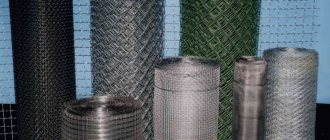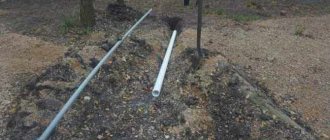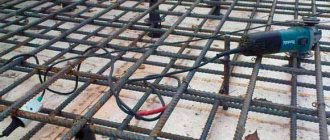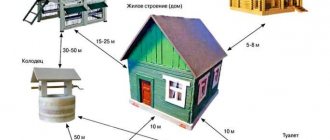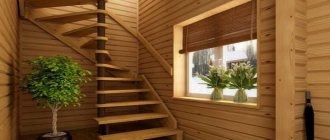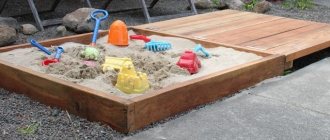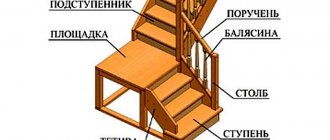Named after Karl Rabitz. In 1878, a German scientist invented a metal mesh, or rather a machine for weaving it. The opinion is controversial. Chainlink's patent number 3789 shows a woven net, not a metal one.
Therefore, they remembered Charles Bernard. He made metal mesh back in 1844. However, the cells of Bernard's product were 6-sided, like a honeycomb. The chain-link mesh is distinguished by 4-sided compartments.
A patent for such a canvas was officially documented in America in 1872 by a certain Peters. This information “surfaced” after the emergence of the tradition of calling the chain-link mesh nothing else.
Types of mesh
From history it is clear that it is correct to say “chain-link mesh” without declining the name, because it indicates that it belongs to a specific inventor. However, in practice, most modify the concept. The grid itself has also changed over the years. It has developed varieties. The division is carried out according to several criteria. The first concerns the material. There are:
1. Not galvanized chain-link. This is exactly what was created in the 19th century. The product is still used in the 21st century. In modern times, uncoated chain-link is used as a temporary material, for example, for fencing areas. Steel alloy rusts when exposed to moisture in the air.
Rust appears a few days after installing the mesh, destroying it after 2-3 years. If you paint a chain-link, it will last up to 5 years. Afterwards, the coating can be updated. In the old days this seemed attractive. Now the majority prefers to dismantle the temporary fence and install a permanent one.
Non-galvanized chain-link mesh
2. Galvanized mesh . Its base is the same black steel alloy. However, it cannot react with atmospheric moisture, since it is covered with a stainless zinc layer. This coated chain-link mesh can serve for decades. Rust is possible only in places where zinc is scratched or where it has been worn away. Therefore, the thickness of the protective layer is important.
Galvanized chain-link mesh
3. Polymer chain-link mesh . It is also metal inside, but the coating is plasticized. Unlike zinc, it can be any color. This makes the chain-link aesthetic, suitable for different occasions. Plastic is as resistant to moisture as zinc.
Polymer mesh chain-link
19th-century chain-link loom Modern devices are configured to produce different variations, producing:
- chain link with square compartments
- grid with rectangular cells
- canvases with diamond-shaped elements
- chain link with hexagonal cells
These are popular variations. In fact, the grid can be even the size of an asterisk. The choice of a specific model is purely a matter of buyer taste. Another issue is the size of the cells.
The strength and bending flexibility of the fabric and the light transmission of the chain-link depend on it . The production of mesh with diamond-shaped cells is carried out within 5-20 millimeters on one side of the compartment.
Machine for making mesh netting
If you make more than 2 centimeters, the drawing, as they say, will float. Therefore, the width of the side of the cell from 20 to 100 millimeters is typical for a square chain-link.
Small animals, for example, chickens, can slip into large cells. Therefore, it is customary to fence chicken coops with chain-link fence with compartments, the side length of which is 1-3 centimeters. In this case, it is worth taking into account possible errors. They are prescribed in TU 14-4-1563. Happens:
- Chainlink of the 1st group. For this, a deviation from the declared cell dimensions of a maximum of 6% is permissible.
- Category 2 grid. Here, 10% error is already acceptable.
The diameter of the wire used also varies. It is considered together with the coating, varies from 1.2 to 6.5 millimeters. The thicker the wire, the stronger the chain-link. The standard one used for barriers is a mesh with a rod diameter of 2.5-3 millimeters and a 5-centimeter cell width.
Compressed mesh netting in rolls
According to the release form, the chain-link can be:
- crimped, where the sheets are shaped along the edges to make it easier to create fences
- rolled 10 or 15 meters long and 150 centimeters wide
The length and width of the rolls vary upon request. The maximum length of the rolled web is 18 meters. The width of a non-standard chain-link can be from a meter to 4 meters.
The required data is indicated in the labeling. It consists of 4-5 characters. The first designates the dimensional accuracy group. The second symbol displays the shape of the cell.
The third character indicates the side length of the mesh compartment in millimeters. The fourth character indicates the thickness of the wire. What remains is the type of coverage. If it is not there, there is no 5th sign. A “0” is placed on a galvanized chain-link.
Marking
Regulatory documentation for construction contains the distribution of reinforcing steels into 6 main classes: AI – A-VI. From the second to the fifth class, products have a ribbed periodic cross-section profile. The strength level of the metal is indicated by Roman numerals. The letter “T” in the marking indicates thermal hardening of products in hot-rolled steels.
There are 2 classes of reinforcing wire:
- BI – distribution structural reinforcement;
- B-II – light working mesh.
If there is a ribbed surface of the wire, add the letter “P” to the designation.
The reinforcing steel used for construction mesh is classified according to the current GOST:
- BI and BP-I – structural reinforcement in heavy meshes, working reinforcement in light ones;
- AI and A-II – hot-rolled steel for the production of reinforcing bars in light meshes as working reinforcement, in heavy meshes as structural distribution;
- A-III – hot-rolled steel for increased mesh strength, the cross-section of which is in the range of 1.2-4 cm;
- At-III-C – the presence of thermally strengthened properties for heavy mesh working reinforcement.
- C – welded structures;
- d, d1 – cross-sectional diameter of longitudinal and transverse rods, respectively;
- a is the release value in the reinforcing mesh of the transverse rods;
- a1, a2 – release of longitudinal rods;
- b, l – width and length of the canvas.
Example. Product marking 3 C – 20 A-II/15 A-II – 150x480 indicates welded reinforcement mesh type 3 with working reinforcement A-II and a diameter in the longitudinal direction of 20 mm, and in the transverse direction – 15 mm, a length of 480 mm and a width 150 mm.
Production of chain-link mesh
In production, you need wire for the chain-link mesh and a production machine. In addition to homemade ones, there are certified factory ones. They are ideal for setting up a full-scale business and are divided into 2 categories:
Wire for the production of chain-link mesh
- Semi-automatic. They cost from 20 thousand rubles. Used models can be sold for 10 thousand. The units are easy to assemble and take up little space. The downside is the need for manual labor. It is required even when bending wire. Therefore, cell asymmetry and other inaccuracies are possible. In addition, a staff of several people is needed.
- Automatic. Such machines cost from 200 to thousands of rubles. Used options sell for 130-150 thousand. One operator can operate the automatic machine. Productivity increases and the accuracy of mesh weaving is maintained.
Automatic machines are placed on the floor. Semi-manual machines require a support table. Automatic machines consume more energy, but can also produce more. On an average semi-manual machine, approximately 18 rolls of 10-meter length with a 5-centimeter cell edge are produced per working day.
The average area occupied by a semi-automatic machine is 1.5 square meters. Fully automated machines are installed on 3-5 squares. Accordingly, in the latter case, the workshop is removed. When working with semi-automatic machines, most entrepreneurs limit themselves to garages.
Conscientious manufacturers undergo voluntary certification in order to comply with GOST 5336-80. It regulates the production of chain-link. Consumers monitor the quality of the purchased product.
Characteristics of galvanized chain-link
Galvanized chain-link differs in the following parameters:
- Cell diameter. Cells can have sizes from 5 mm to 10 cm. The most popular diameter is 5 x 5 cm. It is ideal for any type of fencing.
- Cell shape. It can be square or diamond-shaped.
- Diameter of the wire used. Wire with a thickness of 1.2-5 mm is used. It is recommended to use wire with a thickness of at least 1.6 mm.
- Roll length. It can range from 10 to 18 m.
- Grid height. It can be from 1 m to 4 m. For the construction of fences and similar barriers, a height of 2 m is most often used. If necessary, the mesh can be increased with a second roll to the desired height.
- Cost per meter of material. It all depends on the height of the roll, the diameter of the cells and the diameter of the wire. The larger the diameter of the wire used, and the smaller the diameter of the cells, the more expensive the mesh will be. However, thicker wire improves strength and reliability.
Installation of chain-link mesh
Installing a chain-link mesh boils down to attaching the fabric to pre-dug posts. They can be:
- concrete
- asbestos
- wooden
- metal
The last option is the most popular. Metal poles can be made of pipes or profiles. The latter is taken 60 by 40 millimeters. The pipes are suitable for 60mm diameter. If the products are hollow, the internal space is filled with concrete. Caps are installed on top. This prevents moisture from getting inside the pipes and causing them to rust.
Chain-link fence with reinforcement broach
In order to maintain the integrity of the racks from the outside, they are:
- Clean with a metal brush.
- Degrease.
- Prime with an anti-corrosion mixture.
- Equipped with hooks for fastening the chain-link.
- Grind and prime the places where the hooks are attached.
Chain link fence top
Having prepared the pillars, they begin to stretch the chain-link. To do this you need a set of tools:
- roulette
- level
- Boer
- scrap
- knitting wire
The holes for the pillars are prepared with a drill. Some work with a shovel, but this is long and labor-intensive. A tape measure and a level are used to place the posts strictly vertically on the same line and at the same distance.
Options for attaching mesh mesh
The mesh wire in a roll is attached to the hooks of the posts. The job can be done by one person. It is enough to place the roll vertically at the outermost post, securing it with knitting wire in several places vertically.
Next, the chain-link is untwisted to the next rack, tensioning well. If the tension is low, the fence will sag and sag. At the second post, the mesh is also attached vertically. The manipulation is performed at each of the supports.
Decorative mesh netting
When it comes to installing the mesh, the preparation stage is important, when there is no chain-link or posts yet. In their absence:
- Large plants and stones are removed, leveling the soil along the line of the future fence.
- Mark the places of the outermost pillars with pegs.
- The distance between the extreme points of the fence is divided by 2 or 2.5. This is the standard span length.
- Install intermediate pegs along a thread stretched between the first two.
On a cleared and marked field, it is convenient to drill holes, install poles in them, and attach a chain link. Reinforcement is often threaded over it and below, welded to the supports. This prevents the fence or fence from sagging.
Application of galvanized mesh
Let's consider where in life a chain-link mesh with a galvanized coating is used:
- As fencing for various areas. Usually these are garden plots, dachas, parking lots, closed and guarded areas.
- Construction of partitions in various areas.
- It is used to build enclosures and fences for domestic animals.
- Chain-link mesh is used in construction work for sifting bulk components, as a reinforcing layer when creating monolithic concrete structures. This is much more profitable than using metal reinforcement as a reinforcing frame.
- Wire backing is often used when plastering various surfaces. In this case, galvanized mesh with small cells is used.
- For the construction of road surfaces, production of coating slabs. The mesh is placed inside the concrete structure.
- For securing rock in mines and mining industries.
- As an emergency means when moving a car in difficult conditions. If a car is stuck in sand, mud, or snow, then a piece of chain-link placed under the wheels will allow it to get out of the danger zone without any problems.
- For the construction of gabions as a load-bearing frame. For this, a mesh with a metal thickness of 5 mm is used. The cell diameter used is 10 x 10 cm. Gabions are filled with stones, as a result of which it is possible to form three-dimensional structures of various shapes.
Product price
The price of a chain-link mesh depends on its type and footage. A standard 10-meter roll with a wire thickness of 1.6 millimeters can cost:
- about 700 rubles in the case of non-galvanized chain-link
- from 850 rubles if they sell polymer-coated mesh
- approximately 1,500 rubles in the case of galvanized chain-link
A mesh with diamond-shaped cells is slightly more expensive than canvases with square elements. Also, the price tag depends on the distribution chain. It is usually more profitable to purchase from the manufacturer than from third-party stores that increase their margins.
Main types and parameters for choosing material
There are three types of chain link:
- simple (without additional processing);
- galvanized and reinforced;
- galvanized with a special polymer coating.
The first type is usually used in areas where metal contact with the environment is not expected. Most often, such black mesh is used during plastering work as the main reinforcing material. In this case, costs are significantly reduced compared to conventional plaster reinforcement, while the mesh is convenient for installation.
Galvanized mesh with a special polyvinyl chloride coating
Galvanized mesh is used in all areas, including construction and manufacturing. It has first degree anti-corrosion protection and is able to withstand high and low temperatures for a long period of time. At the same time, galvanized material does not require constant painting; in this case, the paint serves only a decorative function.
The most expensive and reliable type of chain-link is galvanized mesh with a special polyvinyl chloride (PVC) coating. It does not require additional processing, has high anti-corrosion protection and maximum durability. It is used primarily as a fencing area in summer cottages, residential and commercial complexes. Regardless of the coating, the mesh is made from low-carbon steel of medium quality using special technology, which contributes to its affordable price on the market.
Where can I buy
Companies that sell woven mesh offer chain-link with different types of surface, including the popular galvanized one. The enterprises collected in the “Where to buy chain-link mesh” section offer various standard sizes of galvanized chain-link mesh. Thus, any buyer will definitely choose the optimal solution to solve his own problems. In addition, suppliers provide a wide selection of galvanized mesh of various types.
Sections: Chain-link mesh, Galvanized mesh
